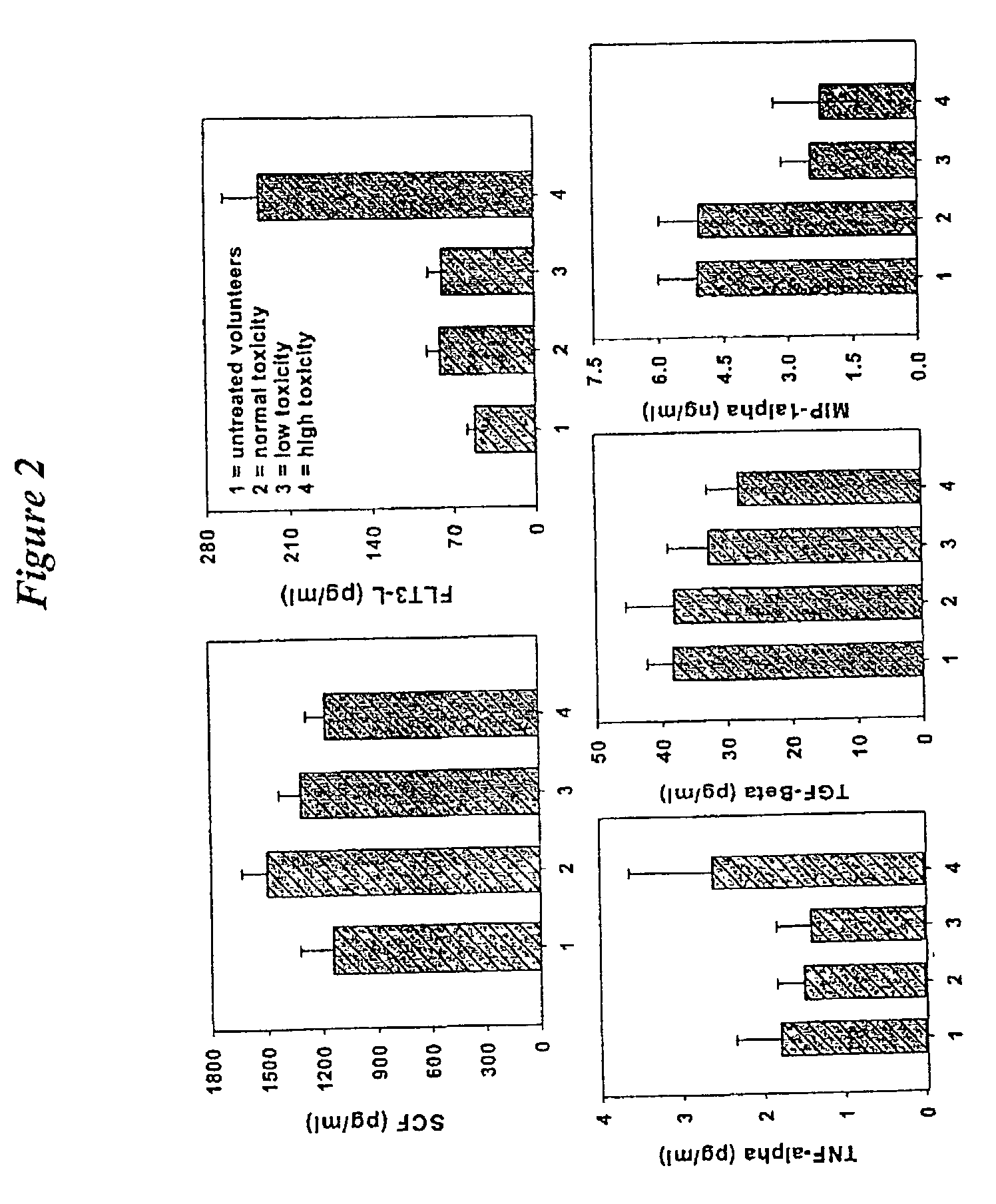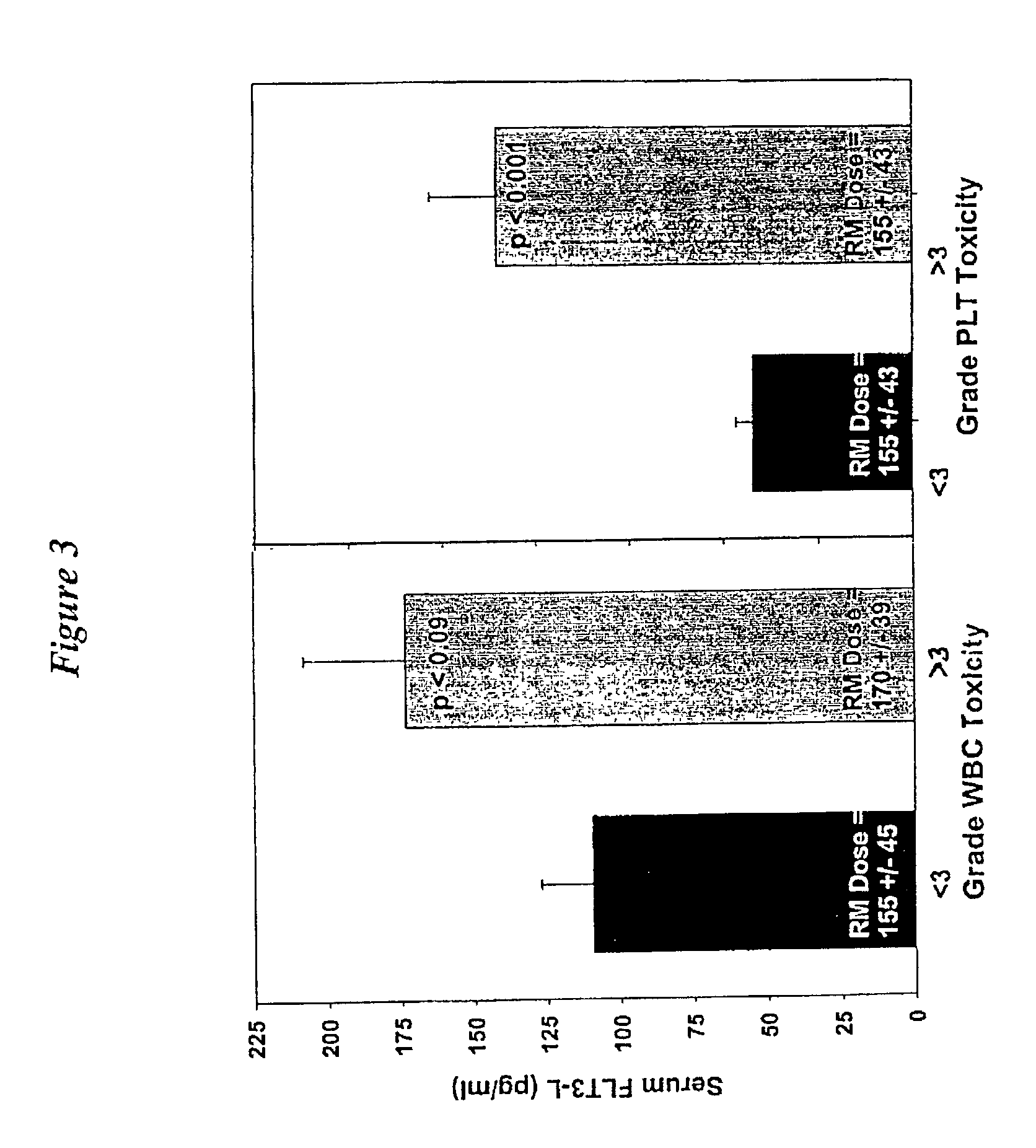Method of determining cytokine dosage for myelosuppressive state
a cytokine and myelosuppressive state technology, applied in the field of cytokine dosage for myelosuppressive state, can solve the problems of more severe toxicity, complication of cancer treatment, and the most common dose limit of chemotherapy-induced myelosuppression, and achieve the most reliable surrogate for predicting complete myelosuppressive recovery
- Summary
- Abstract
- Description
- Claims
- Application Information
AI Technical Summary
Benefits of technology
Problems solved by technology
Method used
Image
Examples
example 1
[0069]This example provides methods useful for practicing the invention.
[0070]Patient Population and Collection of Patient Blood. Solid tumor patients enrolled in Institutional Review Board-approved Garden State Cancer Center clinical radioimmunotherapy (“RAIT”) trials have had multiple cycles of previous chemotherapy using various drugs (e.g., doxorubicin, methotrexate, topotecan, cyclohexyl-chloroethylnitrosourea (CCNU), mitomycin, etc.) and different durations ranging from 1 to 24 months since their previous treatment. Juweid et al., Cancer 80:2749–2753 (1997). Patient blood (3 ml) was collected on the day of scheduled radioimmunotherapy into citrate-tubes and complete blood counts (CBCs) were performed to establish pWBC and PLT counts. Blood was collected every 3–7 days after RAIT and the maximum percent loss, and toxicity grade for both WBCs and PLTs were determined.
[0071]Plasma Cytokine Immunoassays. Plasma FLT3-L, SCF, and TGF-β in patient blood samples were measured by R&D Q...
example 2
[0076]This example demonstrates how to ascertain a statistically significant threshold level of a given cytokine. The methodology is set out in Example 1.
[0077]Seventy-four solid-tumor patients were selected from an initial ninety-nine patients by omitting all individuals with bone marrow metastases and all patients with an initial WBC or PLT count that was unusually high (>10,000 WBC / mm3 or >550,000 PLT / mm3). All patients were refractory to chemotherapy and entered clinical RAIT trials at our research center. The RM dose delivered from the therapeutic dose was calculated for each person. WBC and PLT toxicity were determined at the nadir as the percent loss from the initial count (upper panels) or as grade toxicity (lower panels), and the results plotted against the RM dose (FIG. 1). The majority of patients (52–56 out of 74 for percent loss and 40–44 out of 74 for grade toxicity) conformed to a well-defined linear relationship between RM dose and toxicity (∘).
[0078]However, some pa...
example 3
Adjustment of Red Marrow Dose by FLT3-L Ratio
[0093]Red marrow radiation doses were determined for 30 patients (20 males and 10 females, all without bone marrow or bone involvement, 18 had prior chemotherapy) after receiving 131-RAIT (activity range 2.1–8.9 GBq). Radiation dose estimates were calculated using two different methods of red marrow cumulated activity and red marrow-to-blood activity concentration ratio determinations for two dosimetric models, using both male and female and male-only masses and S values. Highest platelet toxicity grade at nadir (PTG), percent platelet count decrease (PPD), and platelet nadir counts (PN) were measured. FLT3-L levels (pg / ml) were determined by immunoassay prior to treatment; a normal FLT3-L level was assumed to be 80 pg / ml. The red marrow radiation doses (cGy) were adjusted for the patient's FLT3-L level when the patient's cytokine level exceeded the normal value. Marrow doses and FLT3-L adjusted marrow doses were correlated to PTG, PPD, P...
PUM
 Login to View More
Login to View More Abstract
Description
Claims
Application Information
 Login to View More
Login to View More - R&D
- Intellectual Property
- Life Sciences
- Materials
- Tech Scout
- Unparalleled Data Quality
- Higher Quality Content
- 60% Fewer Hallucinations
Browse by: Latest US Patents, China's latest patents, Technical Efficacy Thesaurus, Application Domain, Technology Topic, Popular Technical Reports.
© 2025 PatSnap. All rights reserved.Legal|Privacy policy|Modern Slavery Act Transparency Statement|Sitemap|About US| Contact US: help@patsnap.com



